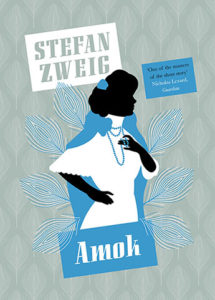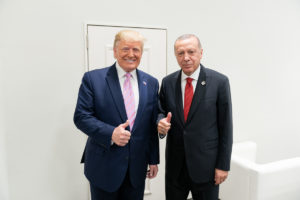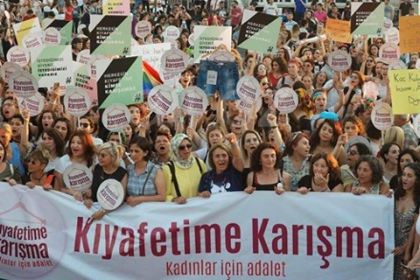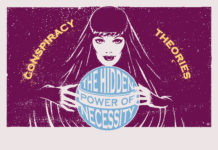In this long read and original essay for the New Pretender, Alev Özkazanç writes about the prevalence of gender based violence against women and members of the LGBTQ community in relation to the crisis of patriarchy and the rise of the figure of the strong man. Her claim is that the appeal to law, state, and family as sites of resistance against the figure she names the ‘Amok Runner’, one who runs amok, is futile, as these patriarchal sites of power have been harnessed by the Chief who permits such violence. At stake, for Özkazanç, is the formation of a new form of bond.
The last scene
It was during the dark days of 2017 when I came across, and found myself surprised by, a piece of statistical data pertaining to the publishing sector in Turkey. The data showed that in 2016 and 2017 the bestselling and most widely read novelist in almost every city in Turkey was Stefan Zweig [1].The fact that Zweig’s well known novellas are readable, cheap and easy to find everywhere (you can find his books along with other classics by Dostoyevsky, Nietzsche and Freud, in every small shop and at the rest stops on highways) could well have provided enough reason for their popularity. Yet, I suspected that there was more to it. I had a strong sense that Zweig’s appeal to Turkish people could be an important clue to understanding the nature of the darkness we have been going through for the last few years in Turkey and in some other countries as well. In fact this connection was illuminated before my eyes when I recalled the very basic and recurrent theme of Zweig’s novellas.

As is well known, the basic tenet of his novellas and especially the ones in Amok and Other Stories,is the obsessive passions which inevitably leads to self-destruction [2]. Zweig tells us the unsettling stories of people in extreme predicaments who are captured by a destructive instinctual drive. And this topic is best and most impressively dealt with in Amokwhere he tells the story of doctor in the Dutch East Indies who is possessed by a combination of power and lust, and, torn between duty and desire. Under the pressure of an extreme obsession, the protagonist ‘runs amok,’ sacrificing his profession, reputation, and eventually his life in pursuit of a desperate drive to chase after a patient he had refused to help before. At one moment in his relentless run, the protagonist likens his case to being “Amok,” a term from Malaysian culture, which he describes as ‘a sort of human rabidness, an attack of murderous and pointless monomania.’ Here we see that the subject who runs amok is driven to destroy and kill, in a fashion that is self-destructive at the same time. Thus, it is a run towards self-destruction as the “Amok runner” annihilates everything on his way.
I think that this theme of murderous but self-destructive drives is of much relevance for understanding contemporary Turkish politics and society, which had been trapped into a devastating ethos of death and martyrdom by way of a resumed war, political violence, and terror between 2015-2018. Moreover, this clue has enabled me to clearly perceive an appalling figure which has alarmingly shown up behind the ever-increasing incidents of femicide as we read in the news. This is the figure of a father, pater familias, who after killing his wife and his children, takes his own life as well. I suggest that this emerging figure of the murderous and suicidal father can be drawn upon to analyse the problem of rampant gender violence in relation to the transformation of political power.
Rewinding
This horrible man and his terrifying act appeared on the scene at the end of a long story. In fact, the story of femicide under perennial patriarchy goes back to ancient history, yet, without going back to the basics, or to the patriarchal history of Turkish society, here, it would be enough to just remind what happened after 2015, a year when the authoritarian-populist turn of the new regime further intensified. Even if the new gender regime got stronger after 2015 under the State of Emergency conditions, its basics, indeed, can be traced back to 2010. Starting with Prime Minister Erdoğan’s insistence that every family should have three kids, and then continuing with his failed attempt to ban abortion in 2012, the subsequent period has witnessed an ever-growing attack on gender equality in many ways. Since then, the pro-natality policies of the AKP government, which promoted motherhood and reshaped family policy in line with Islamic values and neo-liberal populism, have all been strengthened as a plethora of legal-administrative regulations have been made in that direction. Alongside the conservative policy agenda of the AKP government, we have also witnessed the rise of all kinds of misogynist and Islamofascistic interventions into the lives and liberties of women and LGBT people by men in the street, as well as the police, party people, local imams, and all sorts of public officials. All these various forms of interventions eventually combined to result in the formation of a highly oppressive gender regime which works by means of legal regulations, arbitrary administrative acts, police brutality, street level intimidations, and censorship [3]. As for femicide, it is no surprise that the number of women who are killed (mostly by their intimate partners or ex-partners) has steadily risen in the last ten years. According to the statistical data (collected by independent feminist organisations), 2337 women were killed between 2007 and 2017, reaching to 409 killings in 2017 [4]. Needless to say, the rise of the new gender regime coincided with the forced and total reshaping of Turkish politics and society by a constant recourse to state violence, the threat of force and heavy manipulation under the leadership of a Strong One-Man, The Chief, as he is called by his fanatic followers, namely: Recep Tayyip Erdoğan.

Without further ado, I just want to mention two inter-related incidences in order to underline the emergent characteristics of the new gender regime in relation with gender violence and femicide. Gender violence, and especially rampant child abuse and domestic-femicide has long been on the agenda since mid-2000s, and there have been a series of attempts, albeit ineffective, by the government to fight against it up until recently. Yet, with the authoritarian turn of the regime after 2015, the political dynamics behind gender violence gained a different logic of their own. Let me tell you how.
Firstly, I want to shed light to the infamous Report of the Parliamentary Commission on Divorce in 2016 [5]. This report has, since then, virtually functioned as the guideline for the government’s anti-gender agenda. Reflecting the moral panic about the dissolution of the family, the report suggested various measures to complicate the divorce process, such as reconciliation, family counselling and preventive intervention of religious officials. It also included some policy suggestions which would render children and women more vulnerable to abuse and violence. Secondly, let’s consider a Twitter event from 2017 whereby a pro-government journalist and a fanatical follower of the Chief, Fatih Tezcan, posted his views regarding the violence against women. Claiming that his former wife is not allowing him to see his children, he posted tweets like “what would the government have to say, if yet another father kills a mother who isn’t showing their children to him?” and “How dare the state torment fathers regarding the problems of custody?” Furthermore, he succeeded to include the Minister of Family into the debate, seemingly having convinced the Minister regarding his right to custody by accusing the mother of being a ‘schizophrenic, paranoid, atheist, and an enemy of the state.’ When we think of the report and the Twitter event together we can easily realise the truth of the new gender regime: that we are heading from a position in which the state falls short of being preventative when it comes to gender violence, and towards a position in which violence is directly triggered by state policies [6]. Here we see the intertwining of the authoritarian state mentality and the masculinist reactions of the despotic father in a blatant and direct way, something which should be seen as a new dynamic for the Turkish gender regime.
Close Up
All these characteristics of the new gender regime in Turkey have already been well exposed by now and analysed in its many aspects by a growing feminist literature [7]. Yet, despite its valuable contributions, I will dare to say that, at the risk of generalising, the dominant feminist approaches fail to explore properly the problem of unrestrained gender violence. Whether they be scholarly explanations or activist discourses, these approaches consider the increasing gender violence and femicide in Turkey mainly as the end-result and a clear manifestation of a potent traditional patriarchy which is claimed to be recently exacerbated by the neo-liberal and neoconservative regime of AKP. Diverging from the dominant paradigm, I will argue that we need to look in the other direction and start talking about the crisis of patriarchy as the underlying reason behind gender violence running rampant as well as the key to understand the nature of the One-Man regime.

Well, I am fully aware of the difficulties of talking about the ‘crisis of patriarchy’ let alone ‘patriarchy,’ per se, given the state of contemporary feminist theory. The concept of patriarchy has by now been widely questioned by feminist scholars for being based on a binary logic, and, thus, insufficient to grasp the complexities and subtleties of the gender regime as well as the logics of resistance. But maybe the time might have come for us to draw our attention to the more archaic logics of patriarchy as the complex regulations of contemporary gender regimes are being challenged and scattered by means of ever thriving forms of resistance as well as by the evolving masculinist reactions. Moreover, it might also be a bit controversial to talk of ‘crisis of patriarchy’ for the simple reason that patriarchy as we know it from 19th century onwards has always been in a state of perpetual crisis thanks to the unsettling powers of democratic revolution. The patriarchal logics of natural hierarchy and obedience have been further exposed and challenged in its myriad forms with the radical democratic moment of 1968 and we can say that the current wave of reactions represents only a new episode in the hopeless quest to contain the shocking effects of that same year. I think that we are now living in an historical moment where the hegemonic regulations can no longer be achieved at all. Thus, despite all efforts to contain and regulate the crisis by neoliberal or neoconservative policies, these usually end up in aggravating the crisis. That’s why we need to look at the deeper dynamics that lead to the inconsistencies, chaos and dysfunctionalities behind the seemingly functioning regulations.
We are witnessing the historical crisis of patriarchy enter into a new and deeper phase by force of two interrelated developments: first, we must note the ever growing radical-democratic demands of women and LGBT people for equality and freedom which has already shaken the balance of forces in gender relations and dislocated even the foundations of binary gender regimes. And second, with the coming of global post-modern neo-liberalism and its devastating effects on the nature of male-social bonding we see enormous implications for the gendered power relations of all sorts. Therefore this is a world-historic event which is made manifest in myriad but similar ways across the globe. Turkey is no exception to these trends, with its traditional patriarchal family and society shaken in many ways, owing to the changes in the gendered power relations as well as the neoliberal transmutations of the social.

Going back to the question of gender violence in relation to patriarchy, I want to suggest that, in contemporary Turkey gender violence ought to be seen as a symptom of a crisis in the hegemonic functioning of patriarchy. There are only a few feminist scholars who point to this direction. One of them, Deniz Kandiyoti, rightly argues that the ‘masculine restoration’ and the concomitant violence against women point to neither the smooth routine functioning of patriarchy nor the return of traditionalism, but, rather to the fact that the ‘hegemonic submission of women can no longer be secured’ [8]. As she tries to explain the reasons why the Turkish judiciary often backs male perpetrators in cases of femicide, she points out that the male loyalty to the state is dependent on what she refers to as ‘male bonding’ and its attendant solidarity against women. This reasoning rightly implies that the political need to remind and recall the crucial male bonding in Turkey has been increasingly urgent for many reasons. I argue that by reading Zeynep Direk’s work on gender violence we can have a sense of these precise reasons. Direk argues that male bonding is greatly damaged due to the “disposability” of increasing numbers of men. By drawing on Balibar’s work on violence and on the concept of the ‘disposable man’ developed by Bertrand Ogilvie, Direk asserts that the disposable man could only be ultra-subject (against the oppressing powers) by identifying with the sovereign man in power in his capacity to oppress women and children. Moreover, she puts an important question to us asking “whether this should be called a ‘masculine compensation,’ or a return of the patriarchy and its potentials which are assumed to have been surpassed by the legal modernity, as modernity haunted by patriarchy” [9].
The Thing and the primal scene
I basically agree with what Kandiyoti and Direk argue. Yet, there still remains something, something strange which does not properly fit the scene and needs to be deciphered. It is the appalling figure of murderous-suicidal father, which I think, is difficult to be placed easily within the scene of a restored patriarchy and masculine power. I suggest, by concentrating more on this figure we can come to understand the deeper dynamics of the patriarchal crisis which shatters any illusions of a happy return to the original patriarchal contract. I think that it is crucial not be misled by the joint rise of the One-man together with the family father, an alliance which is reflected in the advance of national-authoritarian populisms all over the world. Looking at this affinity, one could easily assume that the One-Man sides with and promotes the family father, pater familias, but that would be wrong. It is true that classical patriarchy was based on the co-evolution and of co-functioning of the state, law, and the patriarchal family. However, what we see in our age, in fact, is the concomitant and a complete fall of all three. That is why, the slogan ‘strong state together with strong family’ is phoney, and what is lurking behind is the terrifying abyss created by the collapse of the Law of the Father. Thus, among the ruins of the decadence, there emerges not the pater familias,but something more terrifying: the primal Father.

This return of the primal Father attests to the alarming possibility that what we are facing now is not the haunting of modernity by patriarchy, but something worse: return of the primal Father as the constitutive outside of patriarchy, something which haunts patriarchy from within. As Freud’s narrative in Totem and Tabootells us, this Father is in fact not the family father who is the pillar of male bonding, kinship, law, and the state [10]. On the contrary, he is the Chief of the herd who knows no laws, recognizes no limits or boundaries to his jouissance,keeping all women for his use and alienating young males, and who, in the end, is destined to be murdered by his sons in order to be able to establish a lawful human society under the Law of the Father.
According to the Freudian narrative, this constitute act of violence against the despotic father has many implications for the unfolding of patriarchal civilisation. Whenever the state and its religion are asserted and people are called for submission to hierarchy and oppression, there we see the guilty conscience of original sin against the despotic Father is in force. And sometimes in history, there comes a time when One-man comes forward alleging a claim to the rights of the omnipotent Father for himself. The One-man arising above his fellow men as well as the state, the religion and the family, represents the law-violating figure with all sorts of transgression and aggression. An impertinent and shameless form of forcing and bending to the point of destruction the limits and boundaries of the established hegemonic order. In all, we see the same logic of abuse of all kinds of authority positions in politics, together with the widespread impulse-control disorder at the psychic-social level. In the midst of the ruins of the symbolic order, we see the collapse of the law, the state and the family altogether. Then comes the femicide, and all other types of gender violence, violence to animals, and child abuse, all perpetrated by the father or the father-like figures. The paradigmatic figure of the despotic father is the father who kills his wife, his children and himself. It is the murderer, abuser, and the suicidal father all at once.
So, what has all of this got to do with the theme of suicide and self-destruction? I believe that the theme of self-destruction attests to the immediate limits to the quest of omnipotence by One-Man regimes as well as the hopeless and impossible drives for absolute oppression by the family fathers. Thus, obsessed and captured by the pervert idea of jouissance, both the One-man at the top and the family men at the bottom run amok. They are “Amok runners” who “run forward captured with the obsession of the target”. This means that this frantic and relentless run forward could only result in their self-destruction.
The other scene
Today, faced with the rise of far-right populisms everywhere, some might hope that the Amok runners could a blocked by the strengthening of the state and its law, or through religion and by family. This would be improbable because all these patriarchal sites of powers are now being harnessed for the runner. The only way forward seems to be to reimagine and reinvent another scenario where the basic social bond between human beings is not seen as conditional on the supposed powers of any constitutive outside of the Despotic Father (either as dead and resurrected in the form of Law of the Father or in the form of One-Man), but on the acceptance of the radical equality of all fellow human beings of all genders.
Alev Özkazanç is a Professor of Political Science and Gender Studies. She has retired from Faculty of Political Sciences, Ankara University in 2016. Currently, Alev is a visiting scholar at Wolfson College at the University of Oxford. Between 2008-2016 Alev was the Director of Graduate Programme on Gender and Women’s Studies in Ankara University. She has also worked as an active member of KASAUM (Ankara University Women’s Studies Centre) and has been one of the founding members of the Support Centre Against Sexual Harassment. Her academic interest focuses on the political sociology of neoliberal societies, mostly Turkey, the biopolitics of gender, anti-gender mobilisations in the face of authoritarian populisms, gender violence in relation with neoliberal and authoritarian regimes, radical democracy and feminist movements.
Alev’s published books are: The New Right and After: Writings in Political Sociology (Dipnot, 2007), Neoliberal Appearances: Citizenship, Crime and Education (Dipnot, 2011), Sexuality, Violence and Law (Dipnot 2013), Feminism and Queer Theory (Dipnot 2015). Also she is the co-editor (with Betül Yarar) of Bob Jessop: The Capitalist State (İletişim, 2005) and the translator of Jane Gallop’s book Feminist Accused of Sexual Harassment (2013).
References
[1] www.idefix.com/turkiye-ne-okuyor
[2] Stefan Zweig, Amok and Other Stories, Pushkin Press, 2007.
[3] For an expansive evaluation of violation of women’s rights see the Report submitted to Council of Europe by F. Kerestecioğlu, ‘Türkiye’de Kadın Hakları İhlalleri Raporu, 2016.
[4] Kadın Cinayetlerini Durduracağız Platformu 2017 Raporu. www.kadincinayetlerinidurduracagiz.net. Also see: Bianet, Erkek Şiddeti çetelesi, bianet.org/kadin/bianet.
[5] See: https://ailevecalisma.gov.tr
[6] For the latest formation of state policy in relation with İstanbul Treaty see the pieces written by Nisan Kuyucu for Bianet. ‘Ayrımcılık Önlenmiyor, Resmi Söyleme Dönüşüyor’, 14 Haziran 2017, Bianet. Also: ‘İstanbul Sözlesşmesi ne diyor, devlet ne yapıyor?, 17 Haziran 2017.
[7] S. Coşar and M. Yegenoğlu, ‘New Grounds for Patriarchy in Turkey: Gender Policy in the Age of AKP’, South European Society and Politics, 2011, 16:4; and, F.Acar and G. Altunok, ‘The politics of intimate at the intersection of neo-liberalism and neoconservatism in contemporary Turkey’, Women’s Studies International Forum, 2013, n.41.
[8] Deniz Kandiyoti, ‘Locating the politics of gender: patriarchy, neoliberal governance and violence in Turkey’, Research and Policy on Turkey, 2016, n. 1:2
[9] Zeynep Direk, Cinsel Farkın İnşası: Felsefi Bir problem olarak Cinsiyet, Metis, 2018. p. 110.
[10] S. Freud, Totem and Taboo, Routledge, 2001. see also S. Žižek, The Ticklish Subject: The Absent Centre of Political Ontology, Verso Books, 2009, ch 6. ‘Whither Oedipus?’.




